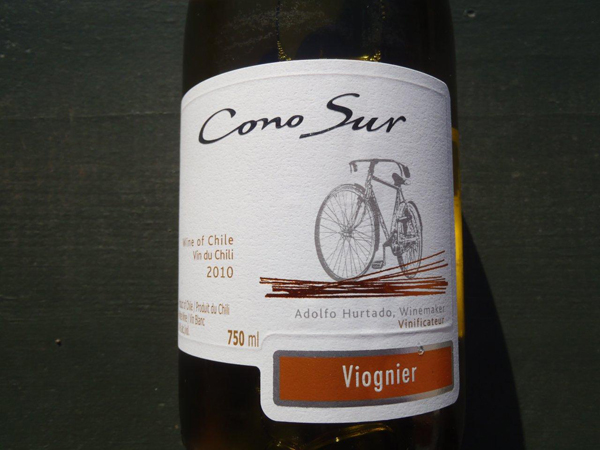I was at the liquor store the other day and ended up talking to a reader who was feeling unloved by white wines. She found gewurz and riesling too sweet. She found many of the blends both too sweet and too thick, “Syrupy!” was her word. But her old stand by, pinot grigio gave her the blahs.
My guess is that she, like many other people finds the aromatics in wines like gewurz and riesling overpowering. I steered her toward a pinot blanc, which I figured she would find interesting and a Canadian sauvignon blanc, which tend to be more delicate than New Zealand style.
I rather like aromatics myself, and had she not instantly rejected my suggestion, I would have nudged her towards viognier. This is a grape that is immensely popular amongst wine growers, and drinkers who have been exposed to the wines of southern France. It’s a bit thicker, more towards the syrupy side of life than a lean pinot grigio. I have occasionally been able to coax red zealots to try a bottle with fish to (grudging) approval. The wine is also hard to say – official French pronunciation is VEE-ahn-yay if you’re curious but vee-OG-ner works with more than a few folks loading shelves.
Regardless of the reason – weight, aromatics, or pronunciation – this is a wine that struggles for love amongst regular folks. I actually think it hits the perfect middle note between acidity, roundness, and aromatics myself. It is subtle enough to not be intrusive but still offer all of those sterling characteristics.
There are alas only three pure viognier here. I’m not a purist by the way. In the Rhrone they blend it with marsanne and roussanne and more power to them. (Although the much sought after Chateau Grillet bottles their vintages 100 per cent Viognier.) The particular three here give the drinker an opportunity to dial in and out the flavour set as they wish by the simple expedient of price.
Essentially less expensive wines are less concentrated. In the old days this was to allow for aging, but in modern times, I have a distinct suspicion it is to cater to senior taste buds. Reason aside, the point is if you find a particularly wine over powering, before you completely abandon the grape like my reader above, start buying the cheapest versions of the varietal and see if they work for you. They may not, but they just might help folks with more discerning tastebuds.
Cono Sur for example is a very lightly extracted viognier. A connoisseur would call it watery, but it is still a very pleasant wine. The biggest thing dialed back on this wine is the herbaceous astringency, the mid palate and finish of a “good” (i.e. Californian) viognier. It still has that pleasant peachy nose with an underlying mineral (usually described as wet stone). The acidity is present and accounted for but not aggressive and the finish just a bit thicker than a pinot grigio or sauvignon blanc.
Smoking Loon is an interesting label. They price low enough that you will occasionally run into some inconsistency but in general they aim at a sophisticated palate with a thin wallet. They are of course Californian so their wines will always be a bit over the top; but on the other hand if you need to figure out what exactly to expect from a grape, such overwrought theatrics are quite useful. The bouquet is stronger with a little more of that lime flower, crushed foliage smell about it, with less of the mineral. The palate is much more like a bigger wine with a strong herbaceous finish. If you’ve never been exposed to such a wine this is a must-try at this price, but I am unsure how many readers will shriek “Eureka!” after drinking. Certainly some of us do.
Finally there is the Sandhill Small Lots Viognier. This is a tiny production that somehow finds a way here. (The winemaker, Howard Soon, one of Canada’s smartest winemakers grew up in Winnipeg, and lived all over the prairies for a while as a brewmaster.) His Small Lots program is one to notice.
It is a much subtler wine than Smoking Loon, with the herbaceousness restrained but present. The bouquet is also much quieter, with the mineral barely whispering to you. It has a slightly peachy nose, a tremendously balanced palate with a finish that is pure, slightly astringent and lingering. If ever there was a wine to savour it is this one.
I could probably make my reader, the woman I met in the store a convert with this one but not everybody wants to learn a varietal’s characteristics by tossing $30 on the table. On the other hand, if you like fine wine this is one of the finest you’ll find.
Finally if you spot one, buy a Rhone Viognier some time. Chateau Grillet is always worth drinking, and I saw Laurus Viognier on the shelf in Manitoba last year, which is another great deal at $15.
Sandhill Small Lots Viognier, Okanagan, 2011. $29 *****
Smoking Loon Viognier, USA, 2011. $15 ****
Cono Sur Viognier, Chile, 2012. $14 ****
–
James Romanow writes about wine and all things boozy for the Spectator Tribune. Follow him @drbooze.
